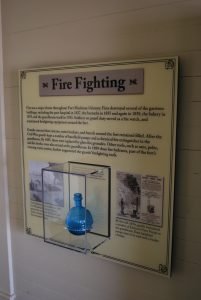

Fort Mackinac suffered structural loss from fires during its use as a military post between 1780 and 1895. Two of the major fires that damaged Fort Mackinac occurred in the years 1855 and 1858. Both fires destroyed several buildings including the barracks. In 1855, the fire started from below the barracks in the cellar which then spread to the barracks chapel, kitchen, and two other nearby facilities. In 1858, the troops of Fort Mackinac were faced with another threatening fire after they had reconstructed the barracks. This fire took place in the bakery, but, to great surprise, grew and demolished the new barracks along with several other smaller buildings. Following these two fires and the Civil War (Fort Mackinac was virtually abandoned during the Civil War), Captain George Brady suggested the use of fire grenades for firefighting within Fort Mackinac. During the mid-1880s, fire grenades were introduced to the fort as a form of fire suppression. The grenades used within the fort were filled with salt-water.


The fire grenade was popular during the 19th and early 20th century for extinguishing fires. They were designed to be thrown into the fire with the glass bulb-shaped grenade shattering and the contents extinguishing the flames. At the beginning of their production, the grenades were filled with salt water. After scientific research, the more effective chemical carbon tetrachloride was used, replacing the salt water. The liquid chemical, when used to extinguish a fire, would inhibit the chemical chain reaction of the combustion process.




The MSHP collection has two glass fire grenades. One is on display in Fort Mackinac’s guardhouse while the other is safely in storage, due to it containing carbon tetrachloride. Carbon tetrachloride, although very effective in extinguishing fires, was found to be highly toxic to humans. The hazardous chemical contains both carbon and chlorine elements, which when heated forms phosgene gas, a chemical weapon used in the First World War. Exposure to these chemicals can cause serious health issues including damage to the liver, the cardiovascular system, and the nervous system. Fire grenades were eventually replaced with the introduction of fire extinguishers which used safer chemicals.








